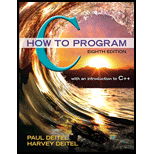
(Memory Allocation and Deallocation Operators) Compare and contrast dynamic memory allocation and deallocation operators new, new [], delete and delete []:
To compare and contrast dynamic memory allocation and deallocation operators new, new[], delete and delete[].
Explanation of Solution
The following table shows the differences.
| S. No. | New | Delete | New[] | Delete[] |
| 1. | Dynamically allocates memory for a variable or object. | Dynamically de-allocates memory for a variable or object. | Dynamically allocates memory for an array. | Dynamically de-allocates memory for an array. |
| 2. | Arguments passed to initialize class constructor | No arguments needed to be passed to call destructor | Arguments passed to initialize array size (bytes). | No arguments needed to be passed to call destructor. |
| 3. | Memory de-allocation must be done using delete operator. | Memory allocation must be done using new operator. | Memory deallocation must be done using delete[] operator. | Memory allocation must be done using new[] operator. |
| 4. | Returns address of allocated object. | Returns void() and sets memory to NULL. | Returns address of first element of allocated array. | Returns void() and sets all memory to NULL. |
| 5. | For example, int *xPtr; xPtr= new int; | For example, delete xPtr; | For example, int *xPtr; xPtr= new int[10]; | For example, Delete[] xptr; |
Want to see more full solutions like this?
Chapter 18 Solutions
C How To Program Plus Mylab Programming With Pearson Etext -- Access Card Package (8th Edition)
Additional Engineering Textbook Solutions
Starting Out with Programming Logic and Design (5th Edition) (What's New in Computer Science)
Starting Out with C++ from Control Structures to Objects (9th Edition)
Java How to Program, Early Objects (11th Edition) (Deitel: How to Program)
Computer Science: An Overview (13th Edition) (What's New in Computer Science)
Problem Solving with C++ (10th Edition)
Starting Out With Visual Basic (8th Edition)
- Please solve and answer the questions correctly please. Thank you!!arrow_forwardConsidering the TM example of binary sum ( see attached)do the step-by-step of execution for the binary numbers 1101 and 11. Feel free to use the Formal Language Editor Tool to execute it; Write it down the current state of the tape (including the head position) and indicate the current state of the TM at each step.arrow_forwardI need help on inculding additonal code where I can can do the opposite code of MatLab, where the function of t that I enter becomes the result of F(t), in other words, turning the time-domain f(t) into the frequency-domain function F(s):arrow_forward
 C++ for Engineers and ScientistsComputer ScienceISBN:9781133187844Author:Bronson, Gary J.Publisher:Course Technology Ptr
C++ for Engineers and ScientistsComputer ScienceISBN:9781133187844Author:Bronson, Gary J.Publisher:Course Technology Ptr C++ Programming: From Problem Analysis to Program...Computer ScienceISBN:9781337102087Author:D. S. MalikPublisher:Cengage Learning
C++ Programming: From Problem Analysis to Program...Computer ScienceISBN:9781337102087Author:D. S. MalikPublisher:Cengage Learning Systems ArchitectureComputer ScienceISBN:9781305080195Author:Stephen D. BurdPublisher:Cengage Learning
Systems ArchitectureComputer ScienceISBN:9781305080195Author:Stephen D. BurdPublisher:Cengage Learning Microsoft Visual C#Computer ScienceISBN:9781337102100Author:Joyce, Farrell.Publisher:Cengage Learning,
Microsoft Visual C#Computer ScienceISBN:9781337102100Author:Joyce, Farrell.Publisher:Cengage Learning, New Perspectives on HTML5, CSS3, and JavaScriptComputer ScienceISBN:9781305503922Author:Patrick M. CareyPublisher:Cengage LearningProgramming Logic & Design ComprehensiveComputer ScienceISBN:9781337669405Author:FARRELLPublisher:Cengage
New Perspectives on HTML5, CSS3, and JavaScriptComputer ScienceISBN:9781305503922Author:Patrick M. CareyPublisher:Cengage LearningProgramming Logic & Design ComprehensiveComputer ScienceISBN:9781337669405Author:FARRELLPublisher:Cengage





